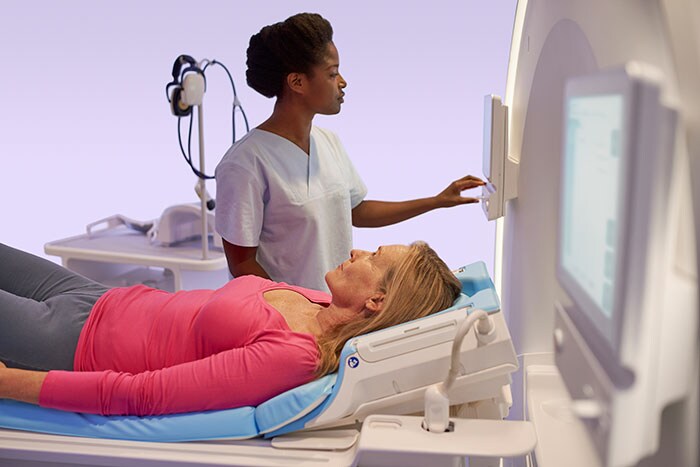As the pressure to provide more accurate diagnoses in less time continues to grow, is AI the answer?
This weekend, the global MR community is gathering in Montreal, Canada for the International Society for Magnetic Resonance in Medicine’s (ISMRM) annual meeting. Increasing pressure on health systems is driving hospital administrators to ask for more from their radiology departments and their MR systems. At the same time, advances in MR in the key areas of speed, patient comfort and diagnostic confidence are increasing the modality’s impact, accelerating patient turnaround and increasing its range of diagnostic capabilities. Artificial Intelligence (AI) is one of the big topics of discussion at ISMRM 2019. Here Arjen Radder, Global Business Leader for MR at Philips, highlights how AI is already contributing to achieving healthcare’s ‘quadruple aim’: better health outcomes, an improved experience for the patient and for staff, and a lower cost of care. What role does MR play in the hospital, and how is that changing? AR: MR has grown to become a key part of the radiology department, and today’s MRI purchases are increasingly becoming more strategic decisions for hospitals to drive greater efficiency and effectiveness for staff, reducing costs while providing outstanding care to patients. This reflects a broader shift towards a value-based care model in healthcare – an approach we strongly believe in. By focusing on value rather than volume, healthcare providers and other stakeholders are incentivized to improve access to care and health outcomes, while reducing the cost of care. AI will have a major impact in healthcare. What is Philips’ overall perspective? AR: The positive impact of AI is being felt across the healthcare industry, but AI alone isn’t enough. At Philips we combine AI and other technologies with knowledge of the clinical and operational context in which they are used – a people-centered approach that we call ‘Adaptive Intelligence’. For the radiologist, that means providing AI-powered tools that are embedded into their workflow and easy to use. Is Adaptive Intelligence already playing a role in MR in clinical practice? AR: We’re already integrating Adaptive Intelligence-powered applications into our MR systems, improving workflow and patient comfort, increasing diagnostic confidence, and increasing speed.
We’re already integrating Adaptive Intelligence-powered applications into our MR systems, improving workflow and patient comfort, increasing diagnostic confidence, and increasing speed.
Our Ingenia digital MR portfolio integrates Adaptive Intelligence-driven SmartExam analytics for automatic planning, scanning and processing of exams, helping improve the entire MR workflow, from image acquisition to reading preference. Supporting diagnostic confidence, across the radiology department our clinically intelligent Illumeo software is designed to change how clinicians see, seek and share information by providing a tailored workflow experience which adapts to their preferences and the patient context. Another example is our breakthrough BlueSeal magnet technology, first shown at ISMRM last year. It’s the industry’s first fully-sealed magnet, dramatically reducing the amount of liquid helium needed to cool the magnet to less than half a percent of the current norm [1]. By incorporating Adaptive Intelligence into the magnet controls we’ve added to the significant operational benefits that BlueSeal offers, enabling a more efficient return to normal operations should an interruption occur. Finally, our VitalEye solution measures and processes over a hundred body locations in parallel to intelligently extract signs of breathing, speeding routine exam set-up times, even for less experienced operators.

How will AI affect the role of clinicians working in MR? AR: Whether it’s the staff on the front desk, the technician running the scan, or the radiologist making the diagnosis, everybody working in MR is under increasing pressure to do more with less, and that’s beginning to have a real human cost: according to recent research by the Advisory Board Company, one of the key imperatives for radiology leaders is to limit turnover and burnout of their current workforce because of the tangible impact it has on quality, cost, productivity and the health of radiologists [2]. By integrating AI in a way that adapts to clinician’s needs and their environment, augmenting their workflows, we can enable them to best harness the power of AI and maximize its impact on all parts of the quadruple aim, including the staff experience and clinical outcomes. In some parts of our portfolio, for example in digital pathology, we’re already supporting clinicians by automatically detecting regions of interest in pathology images [3]. As the development of AI continues to progress, we expect to bring clinical decision support tools into MR. AI has the potential to free up clinicians to spend time on the more rewarding parts of their jobs: engaging with patients to enhance their experience, and engaging with their peers to ensure the best possible diagnosis and treatment for each patient. As the pressure to provide more accurate diagnoses in less time continues to grow, is AI the answer? AI is certainly an important part of the answer, but there are many other innovation areas where we can make progress in order to achieve the quadruple aim. One great example is our breakthrough Compressed SENSE technology, which means scans can be performed up to 50% faster [4]. It’s by harnessing the power of AI in the clinical and operational context in which it’s used, and combining those innovations with advances in other fields, that we’ll be able to have the biggest impact on improving the patient experience, enhancing health outcomes and improving the staff experience, all while lowering the cost of care. As Global Business Leader for MRI at Philips, Arjen Radder is responsible for driving market growth and advancing Philips’ position as a leader of MRI technology and customer-focused diagnostic imaging solutions. [1] The Ingenia Ambition 1.5T with BlueSeal contains less than 0.5% of the helium of a conventional system and this is permanently sealed inside the device. [2] The Advisory Board Company, Retaining and Growing Radiology Talent, 2018©. [4] Using Compressed SENSE technology and compared to Philips exams without Compressed SENSE.
Share on social media
Topics
Contact

Mark Groves
Philips Global Press Office Tel.: +31 631 639 916
You are about to visit a Philips global content page
Continue












